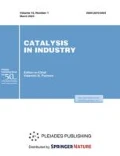Abstract
The resistance to sulfur compounds is considered for nickel, platinum, and palladium metals deposited onto acidic supports, depending on the nature of a support. Catalysts containing nickel, platinum, palladium, and their sulfides as hydro-dehydrogenating components are studied in the reaction of n-octane hydrocracking. The supports are HY, ZSM-5, ZSM-23, and ZSM-12 zeolites and SAPO-11 and SAPO-31 silicoalumophosphates. It is shown that the deposited metals in the hydrocracking catalysts have different resistances to sulfur compounds, regardless of the properties of the acidic support under the conditions of the reaction. The hydrocracking process follows two different pathways, depending on the nature of the hydro–dehydrogenating component (a metal or its sulfides), its activity, and the ratio between the activities of the acidic and hydrogenating components. The first of these determines the predominant cracking of the initial paraffin at the initial stage, while the initial paraffin is subjected to dehydrogenation on the second pathway.

Similar content being viewed by others
REFERENCES
Raseev, S., Thermal and Catalytic Processes in Petroleum Refining, Boca Raton, FL: CRC Press, 2003.
Speight, J.G., The Refinery of the Future, Boston, MA: William Andrew Publishing, 2011, ch. 9, pp. 275–313.
Gosselink, J.W., Transition Metal Sulphides: Chemistry and Catalysis, Weber, T., Prins, R., and van Santen, R.A., Eds., Dordrecht: Springer, 1998.
Bricker, M., Thakkar, V., and Petri, J., in Handbook of Petroleum Processing, Treese, S., Pujadó, P., and Jones, D., Eds., New York: Springer, 2015, pp. 317–360.
Gruia, A., in Practical Advances in Petroleum Processing, Hsu, C.S. and Robinson, P.R., Eds., New York: Springer, 2006, pp. 217–256.
Weisz, P.B., Adv. Catal., 1962, vol. 13, pp. 137–190.
Salakhutdinov, N.F., in Chemistry, Ecology, and Health, Ione, K.G., Ed., New York: Nova Science Publishers, 1995, pp. 65–68.
Landau, M.V. and Kruglikov, V.Ya., Abstract of Papers, Trudy Vsesoyuznogo soveshchaniya “Kataliz reaktsii sernistykh soedinenii” (Proc. All-Union Conference “Catalysis of Reactions with Sulfur Compounds”), Novosibirsk, 1979, vol. 2, p. 108.
Dalla Betta, R.A. and Boudart, M., Abstract of Papers, Proc. 5th Int. Congress on Catalysis, Miami Beach, FL, 1972, vol. 2, p. 1329.
Chukin, G.D., Landau, M.V., Kruglikov, V.Ya., and Agievskii, D.A., Abstract of Papers, Trudy I Vsesoyuznoi konferentsii “Primenenie tseolitov v katalize” (Proc. I All-Union Conf. “Application of Zeolites in Catalysis”), Novosibirsk, 1976, vol. 2, p. 66.
Simon, L.J., van Ommen, J.G., Jentys, A., and Lercher, J.A., J. Catal., 2001, vol. 201, no. 1, pp. 60–69.
Cooper, B.H. and Donnis, B.B.L., Appl. Catal., A, 1996, vol. 137, no. 2, pp. 203–223.
Pawelec, B., Mariscal, R., Navarro, R.M., Bokhorst, S., Rojasa, S., and Fierro, J.L.G., Appl. Catal., A, 2002, vol. 225, nos. 1–2, pp. 223–237.
Yoshimura, Y., Toba, M., Matsui, T., Harada, M., Ichihashi, Y., Bando, K.K., Yasuda, H., Ishihara, H., Morita, Y., and Kameoka, T., Appl. Catal., A, 2007, vol. 322, pp. 152–171.
US Patent 3943053. 1976.
Romannikov, V.N., Ione, K.G., Orlova, L.B., and Zhdan, P.A., Abstract of Papers, Trudy IV Sovetsko-Frantsuzskogo seminara po katalizu (Proc. IV Soviet-French Seminar on Catalysis), Tbilisi, 1978, p. 136.
Funding
This work was performed as part of a State Task for the Boreskov Institute of Catalysis, project no. AAAA-A17-117041710077-4.
Author information
Authors and Affiliations
Corresponding author
Additional information
Translated by E. Glushachenkova
Rights and permissions
About this article
Cite this article
Echevskii, G.V. Study of Bifunctional Hydrocracking and Hydroisodeparaffinization Catalysts Based on Zeolites and Alumophosphates, Part 1: Effect of the Nature and Activity of the Hydrogenating and Acidic Components on the Activity and Selectivity of Hydrocracking Catalysts. Catal. Ind. 12, 77–80 (2020). https://doi.org/10.1134/S2070050420010055
Received:
Revised:
Accepted:
Published:
Issue Date:
DOI: https://doi.org/10.1134/S2070050420010055



